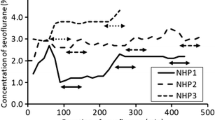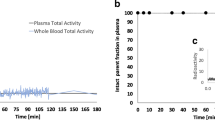Abstract
Purpose
To determine whether brain and plasma equilibrium of a proposed PET tracer for 5-HT1A, [18F]FPWAY, can be achieved in a sufficiently short time for practical use of the brain to plasma equilibrium distribution ratio (DR) to monitor receptor availability with and without isoflurane anesthesia.
Methods
Awake (n=4) and isoflurane-anesthetized (n=4) rats were administered a continuous 60 min intravenous infusion of [18F]FPWAY with timed arterial blood sampling. Brains of the isoflurane-anesthetized rats were scanned with the ATLAS small animal PET scanner; awake rats were not. All rats were killed at 60 min and scanned postmortem for 15 min, followed by brain slicing for autoradiography. Several regions of interest (ROIs) were defined in the PET images as well as in the autoradiographic images. Regional DRs were calculated as total activity in the brain ROI divided by plasma [18F]FPWAY activity.
Results
DRs in the anesthetized animals were constant between 30 and 60 min, indicating that near equilibrium between brain and plasma had been achieved by ∼30 min. DRs determined from postmortem PET data were higher in the isoflurane-anesthetized rats by 24% (not significant) and 33% (p=0.065) in whole brain and hippocampus, respectively. DRs determined from autoradiographic data were greater in isoflurane-anesthetized rats in medial hippocampus, lateral hippocampus, and cerebellum by 33% (p=0.054), 63% (p<0.01), and 32% (p<0.05), respectively.
Conclusion
[18F]FPWAY could be an appropriate ligand for monitoring changes in receptor availability in the serotonergic system using a bolus/infusion paradigm. One possible explanation for higher DRs in anesthetized rats may be a reduction in endogenous 5-HT secretion under isoflurane anesthesia.




Similar content being viewed by others
References
Fletcher A, Cliffe IA, Doulish CT. Silent 5-HT1A receptor antagonists: utility as research tools and therapeutic agents. Trends Pharmacol Sci 1993;14(12):41–8.
Gozlan H, Thibault S, Laporte AM, Lima L, Hamon M. The selective 5-HT1A antagonist radioligand [3H]WAY 100635 labels both G-protein-coupled and free 5-HT1A receptors in rat brain membranes. Eur J Pharmacol 1995;288(2):173–86.
Khawaja X, Evans N, Reilly Y, Ennis C, Minchin MCW. Characterisation of the binding of [3H]WAY-100635, a novel 5-hydroxytryptamine1A receptor antagonist, to rat brain. J Neurochem 1995;64(6):2716–26.
Ma Y, Lang L, Kiesewetter DO, Eckelman WC. Liquid chromatography-tandem mass spectrometry identification of metabolites of three phenylcarboxyl derivatives of the 5-HT1A antagonist, N-(2-(4-(2-methoxyphenyl)-1-piperazinyl)ethyl)-N-(2-pyridyl) trans-4-fluorocyclohexanecarboxamide (FCWAY), produced by human and rat hepatocytes. J Chromatogr B Analyt Technol Biomed Life Sci 2002;780(1):99–110.
Lang L, Jagoda E, Schmall B, Vuong BK, Adams HR, Nelson DL, et al. Development of fluorine-18-labeled 5-HT1A antagonists. J Med Chem 1999;42(9):1576–86.
Jagoda EM, Lang L, Tokugawa J, Simmons A, Ma Y, Contoreggi C, et al. Development of 5-HT1A receptor radioligands to determine receptor density and changes in endogenous 5-HT. Synapse 2006;59(6):330–41.
Lang L, Jagoda E, Schmall B, Sassaman M, Ma Y, Eckelman WC. Fluoro analog of WAY-100635 with varying pharmacokinetics properties. Nucl Med Biol 2000;27:457–62.
Eckelman WC. Sensitivity of new radiopharmaceuticals. Nucl Med Biol 1999;25:169–73.
Fowler JS, Volkow ND, Wang GJ, Ding YS, Dewey SL. PET and drug research and development. J Nucl Med 1999;40(7):1154–63.
Cherry SR, Gambhir SS. Use of positron tomography in animal research. ILAR J 2001;42(3):219–32.
Green MV, Seidel J, Vaquero JJ, Jagoda E, Lee I, Eckelman WC. High resolution PET, SPECT and projection imaging in small animals. Comput Med Imaging Graph 2001;25:79–86.
Seidel J, Vaquero JJ, Green MV. Resolution uniformity and sensitivity of the NIH ATLAS small animal PET scanner: comparison to simulated LSO scanners without depth-of-interaction capability. IEEE Trans Nucl Sci 2003;50(5):1347–50.
Yao R, Seidel J, Johnson CA, Daube-Witherspoon ME, Green MV, Carson RE. Performance characteristics of the 3-D OSEM algorithm in the reconstruction of small animal PET images. Ordered-subsets expectation-maximization. IEEE Trans Med Imaging 2000;19(8):798–804.
Paxinos G and Watson C The rat brain in stereotaxic coordinates. San Diego, CA: Academic Press;1986.
Maekawa T, Tommasino C, Sahpiro HM, Keifer-Goodman J, Kohlenberger RW. Local cerebral blood flow and glucose utilization during isoflurane anaesthesia in the rat. Anesthesiology 1986;65(2):144–51.
Pazos A, Probst A, Palacios JM. Serotonin receptors in the human brain—III. Autoradiographic mapping of serotonin-1 receptors. Neuroscience 1987;21(1):97–122.
Khawaja X. Quantitative autoradiographic characterisation of the binding of [3H]WAY-100635, a selective 5-HT1A receptor antagonist. Brain Res 1987;673(2):217–25.
Hoffman EJ, Huang SC, Phelps ME. Quantitation in positron emission computed tomography: 1. Effect of object size. J Comput Assist Tomogr 1979;3:299–308.
Lanfumey L, Hamon M. Central 5-HT1A receptors: regional distribution and functional characteristics. Nucl Med Biol 2000;27:429–35.
Giovacchini G, Lang L, Ma Y, Herscovitch P, Eckelman WC, Carson RE. Differential effects of paroxetine on raphe and cortical 5-HT1A binding: a PET study in monkeys. Neuroimage 2005;28(1):238–48.
Author information
Authors and Affiliations
Corresponding author
Rights and permissions
About this article
Cite this article
Tokugawa, J., Ravasi, L., Nakayama, T. et al. Distribution of the 5-HT1A receptor antagonist [18F]FPWAY in blood and brain of the rat with and without isoflurane anesthesia. Eur J Nucl Med Mol Imaging 34, 259–266 (2007). https://doi.org/10.1007/s00259-006-0228-x
Received:
Accepted:
Published:
Issue Date:
DOI: https://doi.org/10.1007/s00259-006-0228-x




